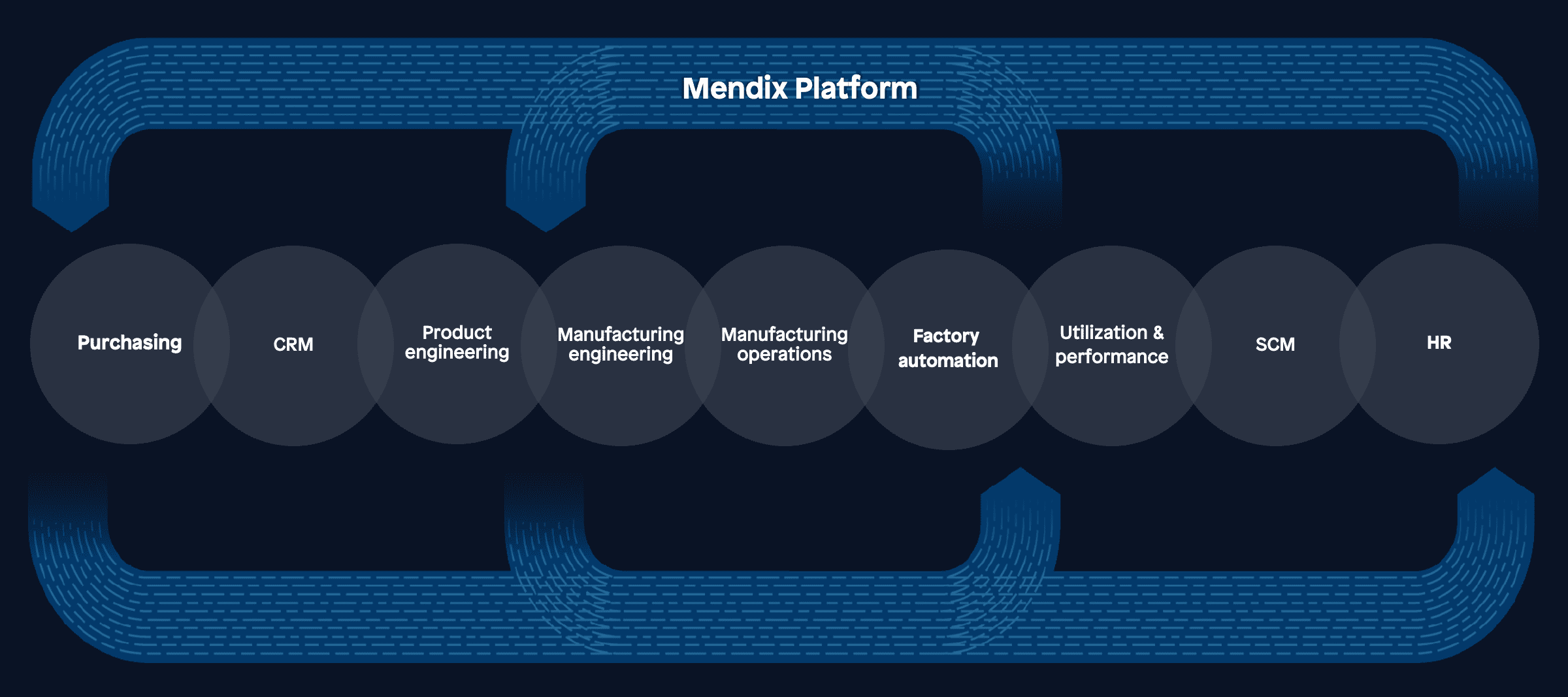The manufacturing outlook for 2022 and beyond is in a constant state of flux. Ongoing challenges like supply chain volatility and inflation have only added to manufacturers’ existing stress from labor shortages, siloed operations, and sustainability pressures. Across the industry — CPG, industrial machinery, automotive, medical devices, etc. — the dire need for agility and resilience can no longer be ignored.
Throughout the volatility of the last few years, businesses have embraced the latest manufacturing industry trends and started the evolution toward building more adaptable organizations. Sixty-seven percent of manufacturers say the pandemic accelerated their adoption of digital technologies, while 88% say that it led them to put more focus on operational resilience.
By incorporating technologies that simplify digitalization, manufacturers can increase enterprise agility and resilience. Read on for a look at three key manufacturing priorities for 2022 and how digital transformation can give the industry a positive outlook for the future.
Siloed operations
Supply and demand instability and evolving consumer needs necessitated an urgent acceleration of innovation cycles. The first step for success here is aligning business domains and stakeholders for transparency into data-driven decision making while automating business processes.
But in many manufacturing organizations, there isn’t always a clear way to connect with other teams. Organizations tend to operate in siloed domains across engineering, production, business operations, and the supply chain and are often sparsely connected from third-party vendors and suppliers.
These silos all rely on a variety of systems and technologies that don’t always align. Business operations may use a combination of commercial-of-the-shelf (COTS) systems and manual processes, while production might rely on a legacy system that predates the internet. Disparate systems operating in silos are costly and risky because teams have a harder time aligning on priorities, IT costs are higher, and adapting to changes in real-time is nearly impossible.
This may be the way things have always been done, but the recent supply chain turbulence has rattled the status quo. Manufacturers are under immense pressure to respond quickly to changing consumer demands, but this is unachievable when data is inaccessible, unreliable, or unavailable and business process automation is scattered among disparate systems.
Companies across all manufacturing sectors have risen to the challenges of pandemic life by embracing digital tools to break down silos and increase the speed of business. Shifting from on-premise to cloud solutions can reduce IT’s infrastructure burden, but there is still the challenge of integrating systems and processes. Digitalizing workflows that impact all domains, vendors, suppliers, and customers creates more data transparency, reduces the risks of human errors on manual systems, and helps manufacturers stay agile. This is also a key requirement for creating new products and business models that fit within the changing landscape of global supply chains.
Related reading: Why the Cost of Maintaining Legacy Systems Only Grows Over Time
Inflation challenges
In the early days of the pandemic, many manufacturers focused on decreasing production and preserving cash flow with just-in-time manufacturing processes and short-term cost cuts. But the decisions made at the start of the pandemic are creating new challenges as we continue adjusting to a new normal.
According to the IMF, rebounding demand, shifting preferences for goods over services, and wage pressures are influencing the rise in core inflation. Gartner reports that 74% of CFOs are worried that margin pressures and inflation will lead to lower profitability. The types of inflation CFOs are dealing with include:
- Wage inflation (60%)
- Raw materials or commodity price inflation (59%)
- Freight cost inflation (51%)
- Salary inflation (50%)
- IT hardware/software/service cost inflation (34%)
- Electronic or semiconductor price inflation (20%)
To manage these high costs, 61% of CFOs responded by raising prices for customers. However, this approach has lasting consequences. Randeep Rathindran, vice president, research, in the Gartner Finance practice explains, “Many CFOs are responding to early input price inflation by passing on costs to customers and failed to make long-term structural changes, such as investing in suppliers to increase capacity and improve costs. The result is they are now faced with eroding margins as they pay higher prices for materials and services as demand has surged.”
With the disruption of COVID-19, manufacturers realized that their existing systems and processes were not flexible or fast enough to adapt. That’s why, in the first year of the pandemic, 85% of companies surveyed by McKinsey reported increasing their focus on accelerating digital transformation — specifically in the realm of making data more visible and accessible. Instead of raising costs for customers, progressive manufacturers are making future-focused moves, like investing in digital tools to create data-driven processes. Clear, transparent data can then be used to assess and predict costly supply chain bottlenecks.
Related reading: 7 Customer Experience Trends to Expect in 2022
Sustainability efforts
Environmental, social, and governance (ESG) factors are now top priorities for customers, workers, investors, and policymakers. A study by Deloitte found that 95% of manufacturing executives plan to invest more in ESG initiatives in 2022 than they did in 2021.
Since manufacturing accounts for one-third of the world’s energy use, sustainability requires a data-driven approach to all manufacturing processes — from product design and production to delivery and after-market and all across the supply landscape. But first, data must be transparent, organized, and accessible. Manufacturers with siloed domains, heavily customized COTS products, primitive legacy systems, and manual processes need to make the move toward digital transformation in a methodical way.
The digitalization of processes along the manufacturing value chain creates a wealth of quality, transparent data for everything from energy use and inventory counts to new products and technologies. Connected devices, data analytics, automation, sensors, and other smart technologies create their own data trails while also helping manufacturers optimize processes, reduce waste, and better forecast consumer demands with sustainability indicators.
For example, the CPG sector is using machine learning to manage energy consumption and increase throughput, and automotive manufacturers are shortening production cycles and increasing efficiency with proactive data-driven decision making. With digital processes, data from these technologies can be accessed in real time and manufacturers can make proactive data-driven decisions to support short-term and long-term sustainability goals.
Related reading: 7 Manufacturing Trends to Watch for in 2022
How to start a digital transformation
While the manufacturing outlook for 2022 may look different for every organization, there is a collective urgency for adaptability across all sectors. From R&D and engineering to manufacturing and the supply chain to finance and HR, digital transformation is a sure-fire way to connect all manufacturing domains, tackle inflation challenges, and build more sustainable processes.
Mammoet Holdings, a global leader in heavy lifting and transport, began a digital transformation by focusing on a top priority: Optimizing the employee experience. Founded over 200 years ago, the company has grown from a small family business to a global enterprise with employees in 45 countries.
Like many other manufacturing companies, Mammoet’s antiquated and disparate systems were major efficiency blockers and stifled all progress toward innovation. Primitive front-end user experiences were in desperate need of attention but updating applications on their existing ERP system required heavy, time-intensive customizations. Using Mendix’s low-code Platform and SAP integrations, Mammoet was able to centralize development and build new interfaces that deliver essential information to various types of users.
Mendix for Manufacturing Industries accelerates digital transformation by creating less disruption to core systems and more engagement across domains. Mammoet continues to utilize Mendix across their global IT landscape.

Interested in learning more? Get started with Mendix for free or check out the Marketplace to browse more manufacturing solutions.

